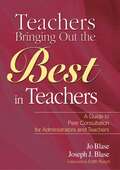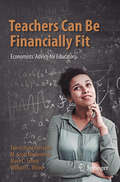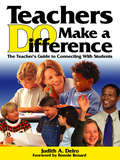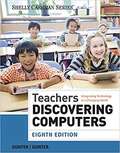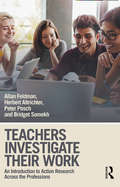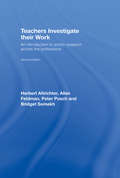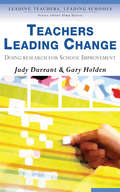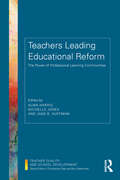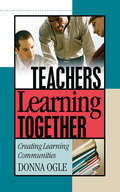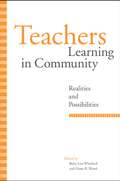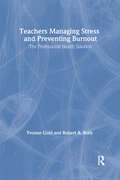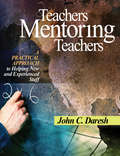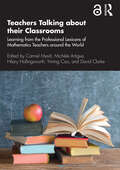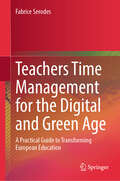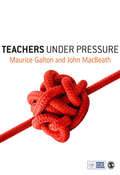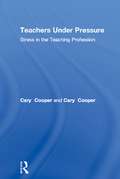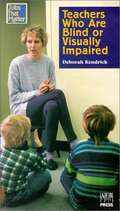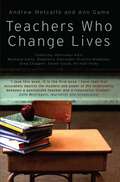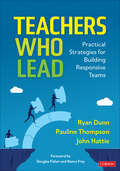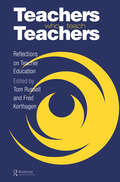- Table View
- List View
Teachers Bringing Out the Best in Teachers: A Guide to Peer Consultation for Administrators and Teachers
by Edith Rusch Joseph Blase Jo BlaseBoost teacher-to-teacher collaboration and learning as a means of informal, but powerful professional development!Most teachers have experienced some kind of formal mentoring or induction program. What these programs can miss is the meaningful daily interaction with peers that builds mutual trust and instructional collaboration. Based on a unique investigative study of nearly 300 teachers, this powerful new resource provides informative teacher perspectives of informal, naturally occurring, teacher-to-teacher professional development. The authors identify the following five teacher behaviors that can positively influence other teachers' morale, teaching skills, and professional growth: Building healthy relationships by communicating, caring, and developing trust Using five guiding principles for structuring learning experiences Planning and organizing for learning Showing and sharing Guiding for classroom managementThis excellent resource helps school leaders promote a culture that encourages lasting professional development. In each chapter, educators share specific experiences and examples, showing each skill in action.School leaders will learn what strong teacher peer "consultants" actually do that leads to improved teacher confidence and motivation, enhanced trust and mutual respect, and reflective instructional behavior among their colleagues. These cost-effective, authentic strategies will build camaraderie and leadership in your school, engaging colleagues as a team in the vital mission of all schools-educating our youth.
Teachers Can Be Financially Fit: Economists’ Advice for Educators
by Mark C. Schug William C. Wood Tawni Hunt Ferrarini M. Scott NiederjohnThis book uses relatable case studies to dispense practical financial advice to educators. Written by an expert team of four award-winning economics educators, the book provides an engaging narrative specifically designed for teachers and their unique financial needs. Educators are attracted to the teaching profession for numerous reasons. Prospective teachers enter the profession believing it offers a certain level of job security and good benefits, usually including a defined-benefit, state-funded pension. But things are changing. Pensions vary widely from state to state and even within school districts. Many private schools do not offer even basic 403(b) saving plans and, when they do, they are often not very generous. Much the same can be said of many charter schools and private colleges and universities. The book consists of fourteen chapters covering a comprehensive group of topics specifically curated for educators teaching at the K-12 and university level, including saving for retirement, managing debt, investment strategies, and real estate. Each chapter begins with a case study of an educator in a specific financial situation, which sets the scene for the introduction and explanation of key concepts. The chapters include a Q&A section to address common questions and conclude with a “Financial 911” focusing on a financial emergency related to the chapter topic.
Teachers DO Make a Difference: The Teacher’s Guide to Connecting With Students
by Judith A. DeiroDeiro provides powerful strategies teachers can employ to build a healthy student-teacher connection, decrease behavioral problems, and increase social and academic skills.
Teachers Discovering Computers: Integrating Technology in a Changing World
by Glenda A. Gunter Randolph E. GunterTEACHERS DISCOVERING COMPUTERS: INTEGRATING TECHNOLOGY IN A CHANGING WORLD, EIGHTH EDITION introduces future educators to technology and digital media in order to help them successfully teach the current generation of digital students.
Teachers Doing Research: The Power of Action Through Inquiry
by Gail E. Burnaford Joseph Fischer David HobsonThis popular text describes the processes of doing teacher action research. But it is much more than a dry presentation of "methods." Filled with examples of teacher action research projects, provided by teachers themselves, the book places teachers at the heart of the action research process. Teachers' own writing about their work and research questions is featured in 11 examples of teacher action research conducted in a range of settings, grade levels, and content areas. The second edition of Teachers Doing Research is fully updated and substantially reorganized and revised, including four totally new chapters and six new teacher stories. This edition: *provides more specifics on teacher action research processes and a variety of methodological options for teachers who do research in their classrooms and schools (Chapters 1-5); *includes more specifics on data collection and interpretation methods (Chapter 3); *balances a detailed introduction to technology for novice researchers with discussion of issues and questions related to technology-based teacher research (Chapter 4). Information on Web sites related to topics addressed in the chapters and teacher research stories is integrated throughout the book. A new Teachers Doing Research Web site (www.teachersdoingresearch.com) invites readers, teacher research participants, preservice candidates, and teacher educators to participate in dialogue with the authors and editors of this text, and with each other; *gives expanded attention to teacher action research with preservice teachers and to university/school collaboration (especially in Chapter 6); *examines the connections between teacher action research and the larger arena of educational research (Chapter 8); *broadens the context for teacher action research, through discussion of its influence on school reform both in the United States and internationally. International examples of urban teacher research are included (Chapter 9); and *offers new In Practice sections to engage readers in opportunities to respond to what they are reading and to try out related activities.
Teachers Have It Easy
by Dave Eggers Henry Louis Gates Ninive Clements Calegari Daniel MoulthropSince its initial publication and multiple reprints in hardcover in 2005, Teachers Have It Easy has attracted the attention of teachers nationwide, appearing on the New York Times extended bestseller list, C-SPAN, and NPR's Marketplace, in addition to receiving strong reviews nationwide. Now available for the first time in paperback, this groundbreaking book examines how bad policy makes teachers' lives miserable.Many teachers today must work two or more jobs to survive; they cannot afford to buy homes or raise families. Interweaving teachers' voices from across the country with hard-hitting facts and figures, this book is a clear-eyed view of the harsh realities of public school teaching, without chicken-soup-for-the-soul success stories.With a look at the problems of recruitment and retention, the myths of short workdays and endless summer vacations, the realities of the work week, and shocking examples of how society views America's teachers, Teachers Have It Easy explores the best ways to improve public education and transform our schools.
Teachers Investigate Their Work: An Introduction to Action Research across the Professions
by Bridget Somekh Herbert Altrichter Allan Feldman Peter PoschNow in its third edition, Teachers Investigate Their Work introduces both the theoretical concepts and the practical methods necessary for readers wishing to develop their action research. Drawing from studies carried out by teachers and other professionals, as well as from the authors’ own international practical experience, the book provides detail on multiple educational contexts from primary education to university training and beyond. It contains over 50 practical methods and strategies to put into action, and explores key areas, such as: the purpose, roots, and varieties of action research collaborating with a critical friend, research participants, or your peers choosing a data collection method observing and documenting situations making sense of your data action research for professional development. This key text also provides crucial tools, such as: a simple ‘quick start’ nine step guide a toolbox for producing written reports a criteria for guiding the quality of action research. A concise yet thorough introduction to action research, Teachers Investigate Their Work is an essential, practical, and easily accessible handbook for teachers, senior staff, and researchers who want to engage in innovation and improve their practice.
Teachers Investigate Their Work: An introduction to action research across the professions
by Bridget Somekh Herbert Altrichter Allan Feldman Peter PoschTeachers Investigate Their Work introduces the methods and concepts of action research through examples drawn from studies carried out by teachers. The book is arranged as a handbook with numerous sub-headings for easy reference and fourty-one practical methods and strategies to put into action, some of them flagged as suitable `starters'. Throughout the book, the authors draw on their international practical experience of action research, working in close collaboration with teachers. It is an essential guide for teachers, senior staff and co-ordinators of teacher professional development who are interested in investigating their own practice in order to improve it.
Teachers Leading Change: Doing Research for School Improvement (Leading Teachers, Leading Schools Series)
by Gary Holden Mrs Judith Durrant`Their book will be of interest to teachers who wish to be proactive rather than reactive. It will be important reading for anyone who wishes to undertake school-based research' - Times Educational Supplement `This is a book which places teachers at the heart of inquiry for improvement. The realism, experience and optimism of each of the writers, shines through each page of the text. It is a "can-do" book which combines discussion of principles, practices and contexts with practical examples of exercises - recommended reading for those wishing to reflect upon the challenges and joys of engaging in teacher-led change' Christopher Day, Professor of Education and Co-Director of the Centre for Research on Teacher and School Development (CRSTD), The University of Nottingham This book shows how to support teachers' leadership of school change. Within a theoretical and policy context, the authors: give practical guidance for integrating inquiry with practice; show how to encourage collaboration and critical dialogue within and between schools; focus strongly on pupil, teacher and organizational learning. The book includes tried-and-tested ideas for aspiring and experienced teacher leaders and researchers.
Teachers Leading Educational Reform: The Power of Professional Learning Communities (Teacher Quality and School Development)
by Alma Harris, Michelle Jones and Jane B. HuffmanTeachers Leading Educational Reform explores the ways in which teachers across the world are currently working together in professional learning communities (PLCs) to generate meaningful change and innovation in order to transform pedagogy and practice. By discussing how teachers can work collectively and collaboratively on the issues of learning and teaching that matter to them, it argues that through collective action and collaborative agency, teachers are leading educational reform. By offering contemporary examples and perspectives on the practice, impact and sustainability of PLCs, this book takes a global, comparative view showing categorically that those educational systems that are performing well, and seek to perform well, are using PLCs as the infrastructure to support teacher-led improvement. Split into three sections that look at the macro, meso and micro aspects of how far professional collaboration is building the capacity and capability for school and system improvement, this text asks the questions: Is the PLC work authentic? Is the PLC work being implemented at a superficial or deep level? Is there evidence of a positive impact on students/teachers at the school/district/system level? Is provision in place for sustaining the PLC work? Teachers Leading Educational Reform illustrates how focused and purposeful professional collaboration is contributing to change and reform across the globe. It reinforces why teachers must be at the heart of the school reform processes as the drivers and architects of school transformation and change.
Teachers Learning Together: Creating Learning Communities
by Donna M. OgleIllustrates how teachers can participate in reading groups, shared staff study, professional networks, and more to create successful learning communities that translate into academic achievement for students.
Teachers Learning in Community: Realities and Possibilities (SUNY series, Restructuring and School Change)
by Diane R. Wood Betty Lou WhitfordThis book raises provocative questions about the efficacy, viability, and sustainability of professional learning communities given the present political and structural realities of public schools. The culmination of six years of research in five states, it explores real world efforts to establish learning communities as a strategy for professional development and school improvement. The contributors look at the realities of these communities in public schools, revealing power struggles, logistical dilemmas, cultural conflicts, and communication problems—all forces that threaten to dismantle the effectiveness of learning communities. And yet, through robust and powerful descriptions of particularly effective learning communities, the authors hold out promise that they might indeed make a difference. Anyone persuaded that learning communities are the new "magic bullet" to fix schools needs to read this book, including teacher educators, educational leaders and practitioners, professional developers, and educational leadership faculty.
Teachers Managing Stress & Preventing Burnout
by Robert A. Roth Yvonne GoldFirst published in 1993. Routledge is an imprint of Taylor & Francis, an informa company.
Teachers Mentoring Teachers: A Practical Approach to Helping New and Experienced Staff
by John C. DareshThis highly interactive guide offers a step-by-step method for planning, implementing, and evaluating mentor programs to maximize teacher satisfaction and productivity.
Teachers Talking about their Classrooms: Learning from the Professional Lexicons of Mathematics Teachers around the World
by David Clarke Yiming Cao Michèle Artigue Carmel Mesiti Hilary HollingsworthDifferent communities, speaking different languages, employ different naming systems to describe the events, actions, and interactions of the mathematics classroom. The International Classroom Lexicon Project documented the professional vocabulary available to middle-school mathematics teachers in Australia, Chile, China, the Czech Republic, Finland, France, Germany, Japan, Korea, and the United States. National teams of researchers and experienced teachers used a common set of classroom videos to stimulate recognition of familiar terms describing aspects of the mathematics classroom. This book details the existing professional vocabulary in each international community by which mathematics teachers conceptualise their practice, and explores the characteristics, structures, and distinctive features of each national lexicon. This book has the potential to enrich the professional vocabulary of mathematics teachers around the world by providing access to sophisticated classroom practices named by teachers in different countries. This one volume offers separate, individual lexicons developed from empirical research, the capacity to juxtapose such lexicons, and an unmatched opportunity to highlight the cultural, historical, and linguistic bases of teachers' professional language.
Teachers Time Management for the Digital and Green Age: A Practical Guide to Transforming European Education
by Fabrice SerodesThis timely and essential study examines how the twin transitions of digitalisation and ecological responsibility are reshaping the foundations of contemporary education. The book explores the systemic shifts in school organisation, professional roles, and working conditions, positioning itself at the intersection of educational management, sustainability, and technological change. It identifies persistent structural barriers that have been a hindrance to the implementation in recent years, ranging from inadequate infrastructure to institutional resistance. It also highlights innovative practices that have emerged through cross-disciplinary collaboration and pedagogical experimentation. Furthermore, it offers solutions that will help overcome the obstacles. Drawing on extensive empirical research and actual case studies, it captures the pressures placed on educators, particularly during crises, and the potential for renewal. A central focus lies in rethinking time use, task coordination, and teacher well-being, advocating for adaptive strategies and institutional support. In alignment with the European Union's strategic agenda, the book calls for an education system that is not only future-ready but also equitable, humane, and resilient.
Teachers Under Pressure
by John Macbeath Maurice Galton`This is a well written and thoroughly researched book on an issue of vital importance. It places the experiences of individual teachers under pressure into the larger UK and worldwide context. Policy makers need to wake up to its messages' - Sara Bubb, Institute of Education, University of London What is it really like to be a teacher in today's demanding classrooms? Maurice Galton and John MacBeath spoke to teachers, parents and students in England, and compared their responses to similar inquiries in Asia, America, Australia and New Zealand. Their findings were disturbing. Teacher stress and workload were persistent themes in the four studies, with teachers frequently stretched to breaking point as they endeavour to 'make a difference' to their pupils' learning and welfare. Issues examined in the book include: - frustrations facing those trying to make inclusive education work in practice - effects of constantly changing policies on the staff required to implement them - loss of status within the teaching profession - reasons for teachers choosing to leave the profession - the consequences of staying on and fighting for what one believes in This fascinating read will be of interest to anyone involved in teaching, school leadership and educational policy.
Teachers Under Pressure: Stress in the Teaching Profession
by Cary Cooper Cheryl TraversOur education system has undergone a process of enormous and rapid change, and all too often teachers have found that insufficient support has been offered to help them cope with this. As a result, most teachers now find that they experience stress of one sort or another at some point during their careers. As a direct reaction to this, the National Association of Schoolmasters and Union of Women Teachers (NASUWT) have commissioned a comprehensive study of the issue of teacher stress. This book reports on the findings of that study, and the implications this has not only for teachers, but also for the pupils they teach. Cary Cooper and Cheryl Travers' book: * helps to identify which teachers are currently at risk of stress * explores how teacher's problems vary according to where they work, their grade, whether they are male or female and the age range they teach * suggests ways in which the problems of teachers can be helped * suggests preventative action to minimise stress and maximise educational experience
Teachers Who Are Blind or Visually Impaired
by Deborah KendrickThe first volume in the Jobs That Matter series, Teachers Who Are Blind or Visually Impaired profiles 18 visually impaired individuals who have successfully fulfilled their dreams of becoming teachers. Included in this volume are educators of different ages, ethnic backgrounds, and geographic locations across the United States, who work in the classroom in ways that are both surprisingly similar and dramatically different from one another. These engaging individuals demonstrate how visually impaired teachers can be effective in their jobs and achieve classroom success and satisfaction. Designed to inspire young people who are blind or visually impaired, their families, and the professionals who work with them about careers that are available, the books in the Jobs That Matter series are meant to expand readers' horizons by showing a wide range of employment possibilities.
Teachers Who Change Lives
by Andrew Metcalfe Ann GameMost of us can recall teachers who changed our lives, teachers who arrived to teach us what we needed to know just when we needed to know it. The amazing thing about such people is they change us so that we become ourselves. It's as if they have a magical ability to know us better than we know ourselves. How does this happen? Where does the power of great teaching come from? In Teachers Who Change Lives, leading Australian educationists Andrew Metcalfe and Ann Game cast new light on the processes of teaching and learning. The authors argue that outstanding teachers do not mould students by pushing them towards the achievement of externally based measurements of excellence (the 'perfect TER score or bust' model), but instead encourage them to reach their full potential by teaching them to follow their passions and interests. In interviews, some of Australia's most respected names-including Stephanie Alexander, Dawn Casey, Greg Chappell, Betty Churcher, Helen Garner, Shane Gould and Michael Kirby-reveal the significant classroom experiences and influential teachers that helped shape their futures. A book for parents of school-age children, for teachers and those interested in becoming teachers, and for all those who remember how teachers changed their lives.
Teachers Who Lead: Practical Strategies for Building Responsive Teams
by Ryan Dunn John Hattie Pauline ThompsonSupport colleagues, inspire collaboration, and drive impactful school improvement. Designed for instructional coaches, grade-level leaders, subject coordinators, and team leaders, Teachers Who Lead highlights proven strategies to enhance teaching practices, foster collaboration, and impact student learning on a broader scale. Drawing from the latest research on teacher leadership, school improvement, and real-world experiences, this practical guide emphasizes the essential skills and mindsets required to bridge teaching excellence and schoolwide leadership efforts. Key features include Diagnostic tools to address complex educational challenges Strategies to create shared high-quality resources that reduce workload and promote consistency Collaborative leadership techniques to strengthen team dynamics and foster collective teacher efficacy Real-world success stories offering insights into what works in educational leadership Reflection questions to apply the book’s ideas in your unique school context Whether you’re just beginning your leadership role or have been supporting colleagues for years, authors Ryan Dunn, Pauline Thompson, and John Allan Hattie provide actionable strategies to build confidence, promote student improvement, and make lasting contributions to your school.
Teachers Who Lead: Practical Strategies for Building Responsive Teams
by Ryan Dunn John Hattie Pauline ThompsonSupport colleagues, inspire collaboration, and drive impactful school improvement. Designed for instructional coaches, grade-level leaders, subject coordinators, and team leaders, Teachers Who Lead highlights proven strategies to enhance teaching practices, foster collaboration, and impact student learning on a broader scale. Drawing from the latest research on teacher leadership, school improvement, and real-world experiences, this practical guide emphasizes the essential skills and mindsets required to bridge teaching excellence and schoolwide leadership efforts. Key features include Diagnostic tools to address complex educational challenges Strategies to create shared high-quality resources that reduce workload and promote consistency Collaborative leadership techniques to strengthen team dynamics and foster collective teacher efficacy Real-world success stories offering insights into what works in educational leadership Reflection questions to apply the book’s ideas in your unique school context Whether you’re just beginning your leadership role or have been supporting colleagues for years, authors Ryan Dunn, Pauline Thompson, and John Allan Hattie provide actionable strategies to build confidence, promote student improvement, and make lasting contributions to your school.
Teachers Who Teach Teachers: Reflections On Teacher Education
by Tom Russell Fred KorthagenThis is a reflection on the education of teachers, written by teacher educators who discuss features of their work and the challenges facing teacher education in the 1990s. The book invites the reader to attempt similar analyses of personal practice and development in their own teaching.; The book deals with the personal development of both new and experienced teacher educators, illustrating how strongly teacher educators are influenced by their visions and by the challenge to prove themselves in the university setting. In addition, the book examines the ways in which teacher educators have acted to promote their own professional development and study their own practices, including writing as a tool for reflection, a life-history approach to self-study, as well as a study of educative relationships with others, and the analysis of a personal return to the classroom. Finally, it takes a broader look at the professional development of teacher educators and offers a challenge to all teacher educators to consider the tension between rigour and relevance.
Teachers Working Together for School Success
by Mario C. MartinezThrough examples, illustrations, and self-assessments, this volume provides the tools teachers need to build the productive working relationships that are the foundation of successful schools.
Teachers and Academic Partners in Urban Schools: Threats to professional practice (Teacher Quality and School Development)
by Lori Beckett'Showing how critical thinking and local democracy can be a spur to very real educational development within schools that are facing severe challenges, this book provides us with one very valuable contemporary resource of hope.' Ian Menter, Professor of Teacher Education, University of Oxford, UK Teachers and Academic Partners in Urban Schools identifies and addresses a major problem for practitioners – teachers, student teachers and teacher educators – working in urban schools burdened by highly restrictive teaching methods and pressures to meet unrealistic benchmarks set by government. In this book, Lori Beckett investigates how to negotiate these tensions and challenges and offers an account of how to elevate practitioners’ professional voice on quality teaching along more democratic lines. The book addresses key issues for teachers in urban schools, such as: fractures in teachers’ professional communities; impacts of imposed marketizing policies and forced performative practices on schools; the complexities of teaching and teachers’ concerns about practice, as well as teaching practitioners’ perception of educational/schools policy. Both academic and teacher partners contribute to the work, showcasing the ways they have engaged with each other in joint work and with local government. Through this, the book supports a professional and politicized dialogue about teaching and teacher education, offering a meaningful account of how to fashion a form of educative schooling for students and families with complex needs. Written by a dynamic and experienced author, this book brings Beckett’s experience to bear on a controversial and complex area – addressing the general trend towards increased regulatory policy in education. It is an essential read for anyone interested in a rich analysis of how practitioners can work to reassert their professional voice and regain control of schools and teacher education, and will also appeal to those interested in the larger project of restoring school democracy.
